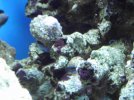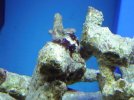Cyanobacteria thrive in low circulation, poorly aerated conditions. Hence the call for vigorous water movement and near-saturation levels of dissolved oxygen. Providing powerheads, small submersible pumps, mechanical aerators and directing discharges from outside filters and pumping mechanisms are the best way to accomplish optimized circulation and aeration. Direct these devices to eliminate stagnant areas....
Siphoning
The bulk of the colonies out. Not only does this work directly in removing the BGA, but something in the way of chemical self-destruction is often triggered in removing the cyanobacteria in this way. A small diameter rigid tube attached to a siphon hose works wonders.
Less Food:
Being careful to make especially major nutrients like nitrates and phosphates limited is important. Be on your guard against overstocking and overfeeding fishes and invertebrates. Also, very importantly, be wary of putting in too much in the way of chemical supplements and to a lesser extent, chemical food from your tapwater and synthetic salt mix.
Enhanced Filtration:
Better foam fractionators utilizing ozone, preserving and increasing redox potential will increase desirable photosynthetic life and decrease unwanted algal forms growth. Practical chemical filtration can be of service in the pre-emptive removal of chemical foods.




